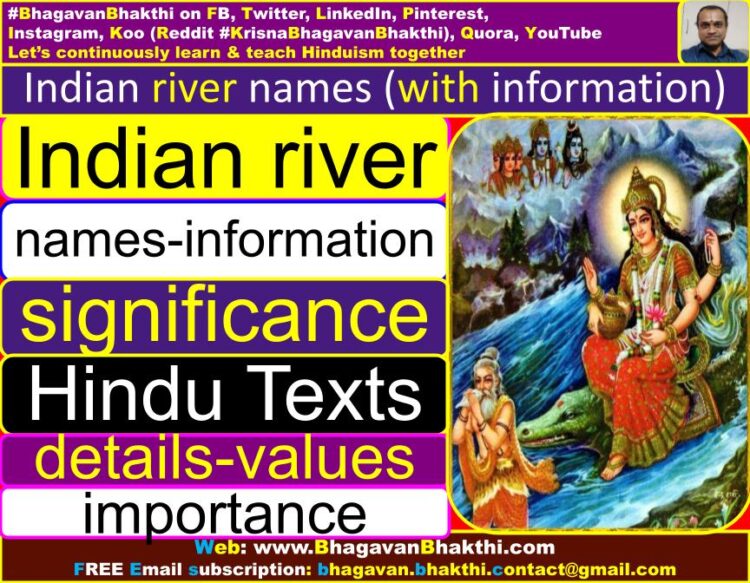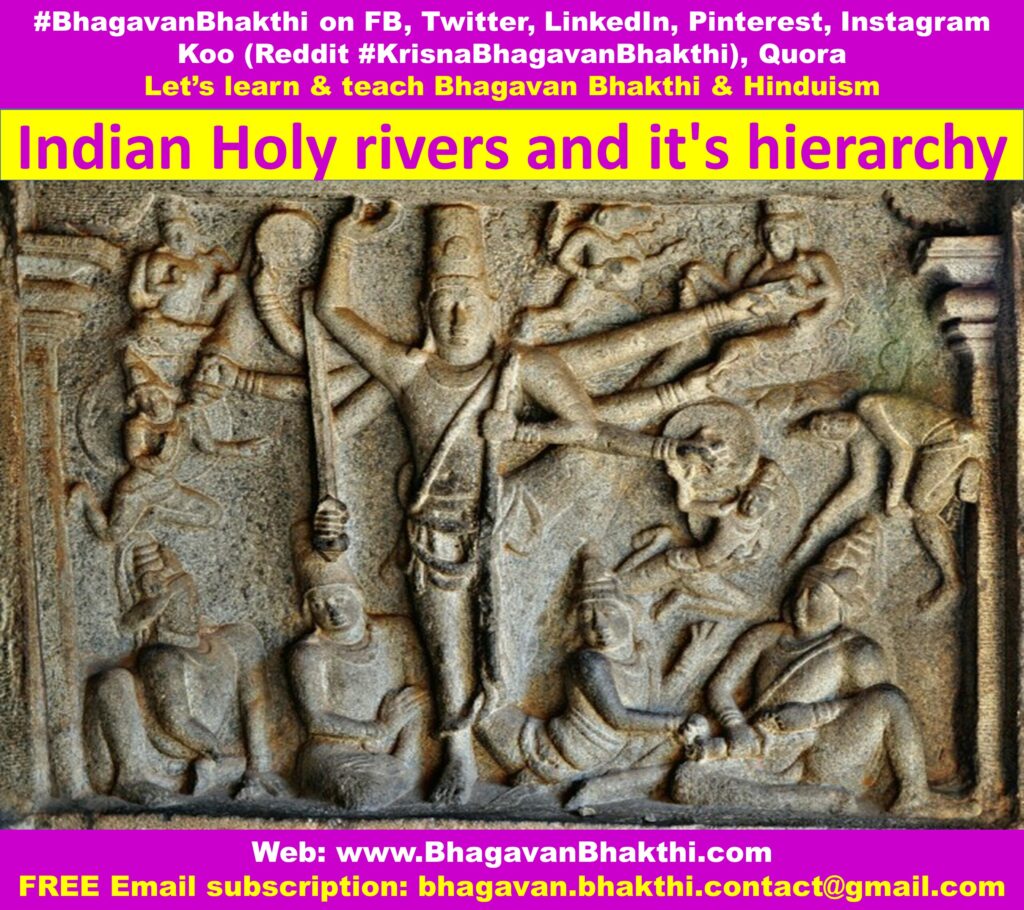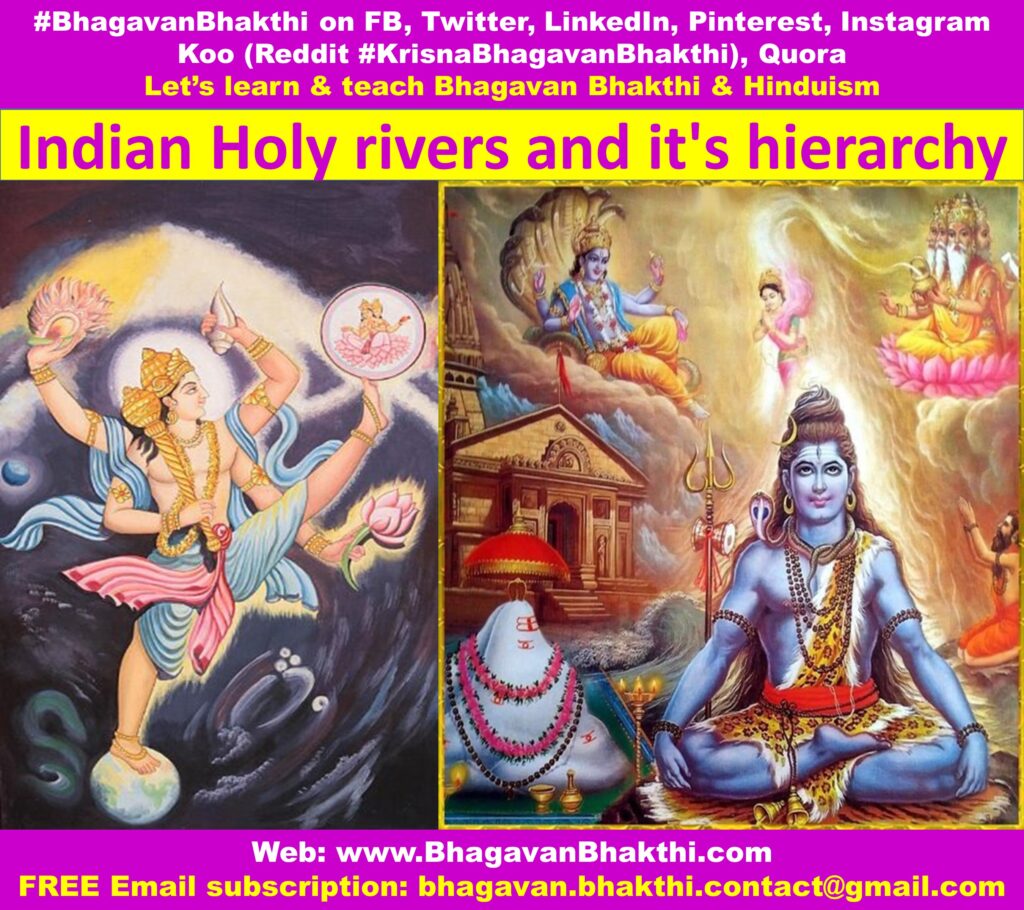List of Indian rivers names (with information) (Hindu Texts)
Namaste friends, how are you doing today? Welcome to #BhagavanBhakthi website / blog.
Bhagavan Lord Sri Vishnu (Krishna) (Rama) blessings to you and your family!
In this website / blog, you will always learn about #Hinduism #Sanskrit language.
Also subscribe to my YouTube channel from this link #BhagavanBhakthi to view videos about #Hinduism #Sanskrit language.
Just before going to “List of Indian river names (with information) (Hindu Texts)“, let us have some brief information.

India (Bharata) (Bharat) (भारत) is the most auspicious and divine country on earth since ‘aadi kalam’ (Grand unknown time).
India (Bharata) (Bharat) has been at the center stage of the world for anything and everything since unknown time.
Earlier, everything used to be from our Great Nation Bharata / India and we used to provide / donate to the world.
It may be water, food, grains, vegetables, metals, knowledge, music, dance, technology, ahimsa, etc. etc. etc. everything used to be from our Great Nation Bharata / India.
Among these, today let us know about the Greatest rivers of the Great Sanatana Dharma as per our Great Shastras (Hindu Texts).

Bharata / India has been at the center stage of the world for anything and everything since unknown time.

List of Indian river names (with information) is as given below:
Ganga river : “Ganga” is most shreshta / supreme or the best among all the rivers as it has come out of the “paada-kamala” (Lotus feet) of Bhagavan Sri Maha Vishnu.
There is extra saannidya (presence) of Bhagavan Sri Maha Vishnu in Sri Ganga Devi.
When Lord Sri Trivikrama roopi Bhagavan touched the Brahmaanda kavaaTa with his right foot’s angusta / thumb finger, the shuddodaka came out of it and entered “satya loka” of Lord Sri Brahma Deva, who stored in his “kamandala” and did prakshalana (sprinkled) on himself.
While other rivers flows in bhooloka only, Sri Ganga Devi flows in all the triloka, and removes all sins, so she is the “shreshta nadi” (Best river).
Sri Ganga Devi flows in Badari, Hrishikesha, Haridwara and enters Bay of Bengal.
Even while doing snaana in ordinary water, we must have the nama smarana of Sri Ganga Devi and the sannidhana of Sri Ganga Devi can be brought there.
When doing snaana in well, sarovara, pushkarini, and rivers we have to give arGya to Bhagavan Sri Maha Vishnu, Sri Ganga Devi and Sri Surya Deva apart from the respective theerthabhimani devatagan.
But while doing snaana in Sri Ganga Devi river, we must give arGya to Bhagavan Sri Maha Vishnu, Sri Surya Deva, Sri Ganga Devi only and not to other theerthabhimani devatagan.
To know about the Greatness of Sri Ganga Devi, you visit my other post. The link for the same is as given below:
What is the greatness of Ganga
Godavari river : Godavari comes next to Ganga in shreshttatva. This is one among the “sapta mahanadi”. Godavari’s birth place is Tryambaka parvata near Nasika.
It flows upto Rajamahendri. “Nadee Taratamya Stotra” by Raghavendra Tirtharu says “Shanmaasa phaladaa gOdaa” meaning the snaana phala from Godavari will be there for six months.
Krishnaveni : Krishnaveni is the sangama / uniting of “Krishna” and “Veni”. She borns in Sahyaadri.
Swami Pushkarini : Swami Pushkarini, Chandrapushkarini and Manasa Sarovara are equal to “Krishnaveni”.
It is in Bhoovaikunta, that is in Tirupathi, where Bhagavan Sri Maha Vishnu has kept his sannidhana through Sri Varaha Svami and Sri Srinivasa roopas.
There are several theerthaas, one among them is Swami Pushkarni Tirtha – where it is said that
While doing snaana in Swamipushkarini, we must have the dhyana as “Bhagavan Sri Maha Vishnu will be standing with Sridevi-Bhoodevi, holding his Shanka, Chakra, and varadamudra.
Chandra Pushkarini : It is a sarovara, which can be found in the fifth praakaara among sapta praakaraas at Sri Ranga.
It is believed that Chandra did penance at this place for more than thousand years as per Sri Vadirajaru in Theerthaprabandha
Manasa sarovara : This is in Himalaya mountain range, which has the special saannidhya of many Devatagan. Kaveri and Saraswathi – Both these rivers are in the same kakshya.
Kaveri : It takes its birth in Bhagamandala Talakaveri. She was earlier Agastya Maharshi’s wife Lopamudra and now born as daughter of “Kavera” Rishi – that is “Kaveri”.
In Srirangam, Kaveri flows in two directions. We can find Kaveri in all the Ranga kshetras viz., Aadiranga – Srirangapatna, Madhyaranga – Shivanasamudra and Antyaranga – Srirangam.
In all these places Bhagavan Sri Maha Vishnu is in the roopa of Ranganatha Svami itself.
Sarasvati : It flows from Himalaya near Shamyapraasa, where there is Vyasashrama in Badari.
In “Prayaga” Sarasvati flows as Guptagamini, along with Ganga and Yamuna – so it is called as Triveni sangama (uniting of the three rivers).
Sarayu : This flows in Ayodhya, that is, in Sri Rama janma bhoomi. This is in the kakshya next to Kaveri and Saraswati.
Sarayu means a part of the Manasa Sarovara river. Here Sarayu = Sara + yu = river’s + Part.
Tungabhadra : “Tungabhadra” and “Sarayoo” both are in the same kakshya.
Tunga & Bhadra are born from the teeth of “Sri Varaha Svami” and joins in Koodli near Shivamogga and flows in Honnali, Mantralaya, etc.
There is a saying “gangaa snaanam tungaa paanam”, meaning the Tunga river is very very tasty.
Kalindi or Yamuna : Yamuna river comes next to Tungabhadra. She is the daughter of Sri Surya Deva from Sanjya Devi and the sister of Sri Yama Deva.
This is also one among the sapta mahanadees. Yamunotri is the janma staana of this river.
As this river flows in Kalinda parvata ranges, it is called as “Kalindi” and Bhagavan Sri Krishna did the Kalinga mardhana in this river itself.
Narmada – Sindu : Next to Yamuna in taaratamya – comes Narmada which takes birth in Vindyaparvata and Sindhu River.
To know the greatness of Narmada river, you can visit this link:
What is the greatness of river Narmada
Bhavanashini : It flows in Ahobila which is the capital of Hiranyakashipu and it is Nava Naarasimha kshetra.
Next to Bhavanashini comes “Kumudhvati”.
Next to Kumudwati comes “Malaapaha” : This removes daihika and maanasika kalmasha in us.
Next to Malaapaha comes “Taamraparni”, “Bheemarati”, “Manjula” and “Pinakini” which are equal in Kakshya.
Tamraparni : This flows in Tirunelveli in Tamilnadu.
Bheemarati : This flows in Pandarapura in Maharastra which is also called as Chandrabhaaga.
Pinakini : This flows as two channels that is, Dakshina Pinakini and Uttara Pinakini, which is said to be the birth place of Trivikrama.
Next – Saagaragaami Rivers – which flows independently and are equal to Bheemarati and joins the Sea.
Next – All other rivers
Next – Pushkarini – Which are usually found in the Eshaanya direction of the devastaanas.
Next – Sarovaraas
Next – Tataakaas – which flows in villages, forests and mountain ranges in half chandrakruti.
Next – Devakhata
Next – Koopaas (wells) – which is about 5 Feet width, created by digging earth and covered with Cement blocks (कुंआ).
Indian river names with Lord Sri Vishnu’s different forms are as given below:
1. Ganga river – It has Lord Sri Madhava Roopa (form)
2. Godavari river – It has Lord Sri Veera Narayana Roopa (form)
3. Krishnaveni river – It has Lord Sri Janardana Roopa (form)
4. Swami Pushkarini – It has Lord Sri Varaha and Lord Sri Srinivasa Roopa (form)
5. Chandra Pushkarini – It has Lord Sri Vamana Roopa (form)
6. Manasa Sarovara – It has Lord Sri Madhusudana Roopa (form)
7. Kaveri river – It has Lord Sri Ranganatha Roopa (form)
8. Sarasvati river – It has Sri Padmanabha Roopa (form)
9. Sarayu river – It has Lord Sri Ramachandra Roopa (form)
10. Tungabhadra – It has Lord Sri Varaha Roopa (form)

11. Yamuna river – It has Lord Sri Yamaputra Krishna Roopa (form)
12. Narmada river – It has Lord Sri Maha Vishnu Roopa (form)
13. Sindhu river – It has Lord Sri Sriman Narayana Roopa (form)
14. Bhavanashini river – It has Lord Sri Narasimha Roopa (form)
15. Kumadhvati river – It has Lord Sri Trivikrama Roopa (form)
16. Malaprabha river – It has Lord Sri Janardana Roopa (form)
17. Tamraparni river – It has Lord Sri Ananta Namaka Roopa (form)
18. Bheemarati river – It has Lord Sri Sridhara Roopa (form)
19. Manjula river – It has Lord Sri Hayagreeva Roopa (form)
20. Pinakini river – It has Lord Sri Keshava Roopa (form)
Rivers Stotram in Sanskrit, Kannada and English:
Rivers Stotram in Sanskrit:
विष्णुपादाब्ज संभूता गंगा सर्वाधिका मता |
ततो गोदावरी न्यूना कृष्णवेणी ततोधमा || १ ||
स्वामि चंद्रा पुष्करिण्यौ मानसं च सरोवरं |
कृष्णवेण्याः समस्ताभ्यः कावेरी च सरस्वती || २ ||
हिनेन्योन्यसमे ताभ्यामाना च सरयू तथा |
गभद्रा समा तस्याः कलिंद्यूना ततोधमे || ३ ||
नर्मदासिंधुसरितौ तत्समा भवनाशिनी |
ततः कुमुद्वती नीचा ततो नीचा मलापहा || ४ ||
ताम्रपर्णी भीमरथी मंजुला च पिनाकिनी |
पृथक् सागरगामिन्यो नद्यो भीमरथी समाः || ५ ||
ततोन्याः सरितो नीचास्तटाकाश्च ततोधमाः |
ततो नीचाः पुष्करिन्णो देवखाताश्च तत्समाः || ६ ||
ततो वाप्योधमास्ताभ्यः कूपाः सर्वाधमा मताः |
स्वोत्तमाघ्र्यं प्रदातव्यं अवरासु न चान्यथा || ७ ||
राघवेंद्रेण यतिना ब्रह्मांडाख्यं पुराणगः |
इत्युध्व्रतः सारभागो नदी नीचोच्च सूचकः || ८ ||
Rivers Stotram in Kannada:
ವಿಷ್ಣುಪಾದಾಬ್ಜ ಸಂಭೂತಾ ಗಂಗಾ ಸರ್ವಾಧಿಕಾ ಮತಾ |
ತತೋ ಗೋದಾವರೀ ನ್ಯೂನಾ ಕೃಷ್ಣವೇಣೀ ತತೋsಧಮಾ || 1 ||
ಸ್ವಾಮಿ ಚಂದ್ರಾ ಪುಷ್ಕರಿಣ್ಯೌ ಮಾನಸಂ ಚ ಸರೋವರಂ |
ಕೃಷ್ಣವೇಣ್ಯಾ: ಸಮಸ್ತಾಭ್ಯ: ಕಾವೇರೀ ಚ ಸರಸ್ವತೀ || 2 ||
ಹಿನೇsನ್ಯೋನ್ಯಸಮೇ ತಾಭ್ಯಾಮೂನಾ ಚ ಸರಯೂ ತಥಾ |
ಗಭದ್ರಾ ಸಮಾ ತಸ್ಯಾ: ಕಾಲಿಂದ್ಯೂನಾ ತತೋsಧಮೇ || 3 ||
ನರ್ಮದಾಸಿಂಧುಸರಿತೌ ತತ್ಸಮಾ ಭವನಾಶಿನೀ |
ತತ: ಕುಮುದ್ವತೀ ನೀಚಾ ತತೋ ನೀಚಾ ಮಲಾಪಹಾ || 4 ||
ತಾಮ್ರಪರ್ಣೀ ಭೀಮರಥೀ ವಂಜುಲಾ ಚ ಪಿನಾಕಿನೀ |
ಪೃಥಕ್ ಸಾಗರಗಾಮಿನ್ಯೋ ನದ್ಯೋ ಭೀಮರಥೀಸಮಾ: || 5 ||
ತತೋsನ್ಯಾ: ಸರಿತೋ ನೀಚಾಸ್ತಟಾಕಾಶ್ಚ ತತೋsಧಮಾ: |
ತತೋ ನೀಚಾ: ಪುಷ್ಕರಿಣ್ಯೋ ದೇವಖಾತಾಶ್ಚ ತತ್ಸಮಾ: || 6 ||
ತತೋ ವಾಪ್ಯೋsಧಮಾಸ್ತಾಭ್ಯ: ಕೂಪಾ: ಸರ್ವಾಧಮಾ ಮತಾ: |
ಸ್ವೋತ್ತಮಾಘ್ರ್ಯಂ ಪ್ರದಾತವ್ಯಂ ಅವರಾಸು ನ ಚಾನ್ಯಥಾ || 7 ||
ರಾಘವೇಂದ್ರೇಣ ಯತಿನಾ ಬ್ರಹ್ಮಾಂಡಾಖ್ಯಂ ಪುರಾಣಗ: |
ಇತ್ಯುಧ್ವ್ರತ: ಸಾರಭಾಗೋ ನದೀ ನೀಚೋಚ್ಚ ಸೂಚಕ: || 8 ||
Rivers Stotram in English:
viṣṇupādābja sambhūtā gaṅgā sarvādhikā matā |
tatō gōdāvarī n’yūnā kr̥ṣṇavēṇī tatōsdhamā || 1 ||
svāmi candrā puṣkariṇyau mānasaṁ ca sarōvaraṁ |
sr̥ṣṇavēṇyā: samastābhya: kāvērī ca sarasvatī || 2 ||
hinēsn’yōn’yasamē tābhyāmūnā ca sarayū tathā |
gabhadrā samā tasyā: Kālindyūnā tatōsdhamē || 3 ||
narmadāsindhusaritau tatsamā bhavanāśinī |
tata: kumudvatī nīcā tatō nīcā malāpahā || 4 ||
tāmraparṇī bhīmarathī van̄julā ca pinākinī |
pr̥thak sāgaragāmin’yō nadyō bhīmarathīsamā: || 5 ||
tatōsn’yā: saritō nīcāstaṭākāśca tatōsdhamā: |
tatō nīcā: puṣkariṇyō dēvakhātāśca tatsamā: || 6 ||
tatō vāpyōsdhamāstābhya: kūpā: sarvādhamā matā: |
svōttamāghryaṁ pradātavyaṁ avarāsu na cān’yathā || 7 ||
rāghavēndrēṇa yatinā brahmāṇḍākhyaṁ purāṇaga: |
ityudhvrata: sārabhāgō nadī nīcōcca sūcaka: || 8 ||
More information will be added to this on regular basis, please visit after some time to know more information.
To watch videos on #Hinduism #Sanskrit language, SUBSCRIBE to my YouTube channel from this below link:
#BhagavanBhakthi YouTube channel
Know more information about “Indian rivers information, divinity, etc.” from here:
Indian rivers information, divinity, etc.
Continue reading to know about “Lord Sri Vishnu information (facts) (details)” from here:
Lord Sri Vishnu information (facts) (details)
Continue reading to know about “Lord Shiva (full) information (facts) (details) – Part 2 of 2” from this below link:
Lord Shiva (full) information (facts) (details) – Part 2 of 2
To watch about “Lord Sri Krishna information” YouTube video, click the below YouTube video link:
Lord Sri Krishna information (YouTube videos)
To read about “Lord Sri Krishna information (website / blog reading)“, please click the below link:
Lord Sri Krishna information (website / blog reading)
Dear friends, if you need any clarifications about this post, kindly let me know, I will definitely try to answer all of them.
Also your one LIKE, one COMMENT, One Share, one SUBSCRIPTION is highly important.
This will help to know the quality of this content and also it will be helpful to know if any improvements is required for the content.
If you feel this content is useful to you and has helped you to improve your knowledge, kindly share this with your well-wishers.
Because “SHARING MEANS CARING”.
To receive FREE EMAIL SUBSCRIPTION about #BhagavanBhakthi, you can send an email to [email protected] from your email ID.
NAMASTE!
Sri Gurubhyo Namaha
Sri Krishnaaya Namaha
Sri Krishnaarpanamastu
Share in Social Media